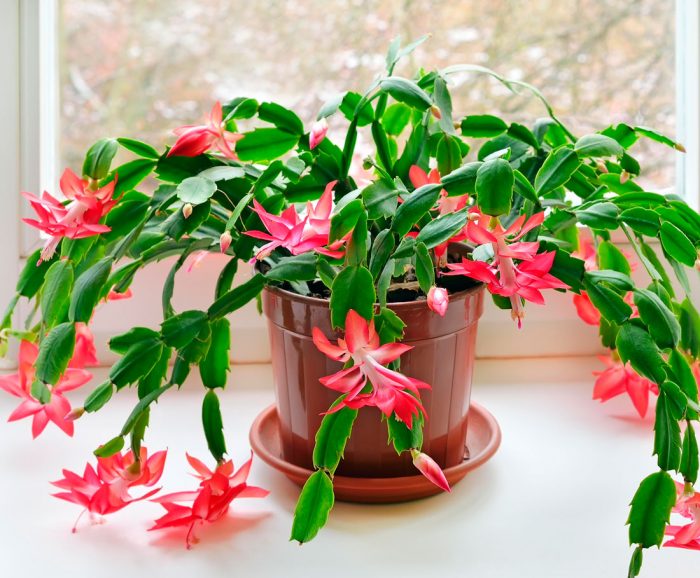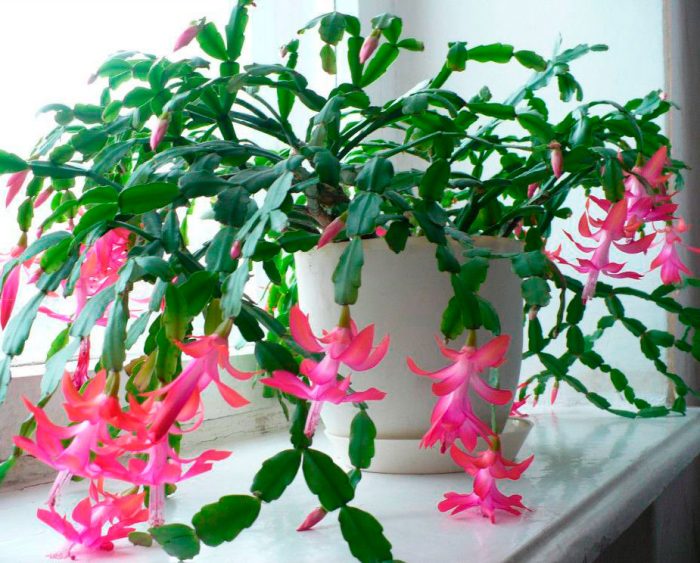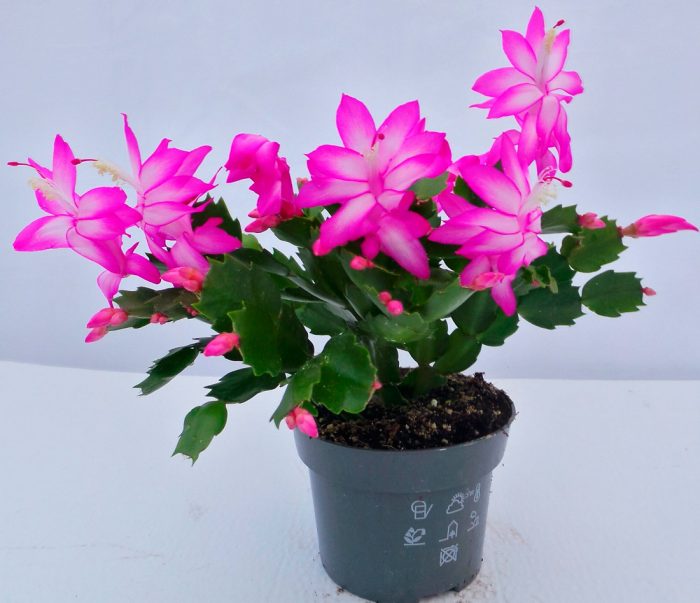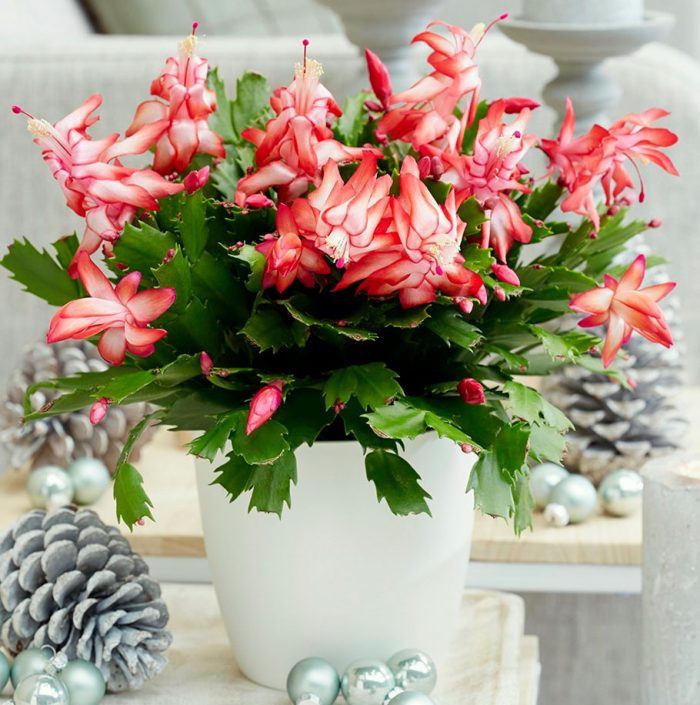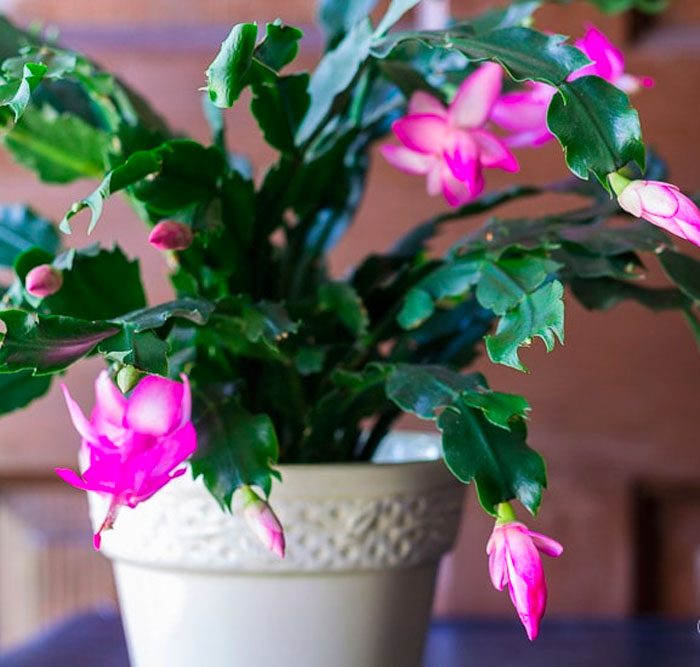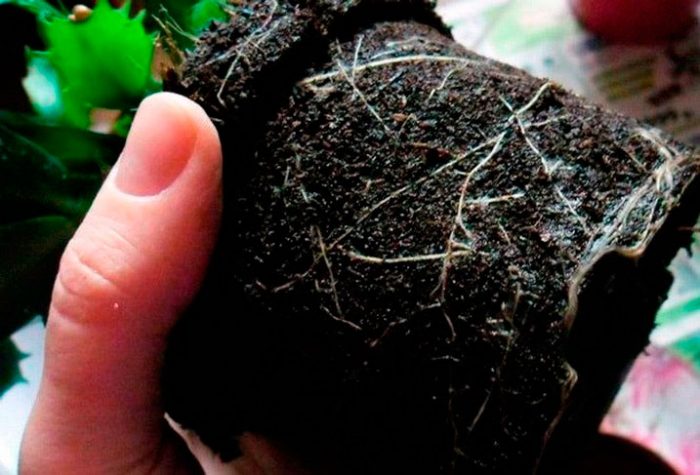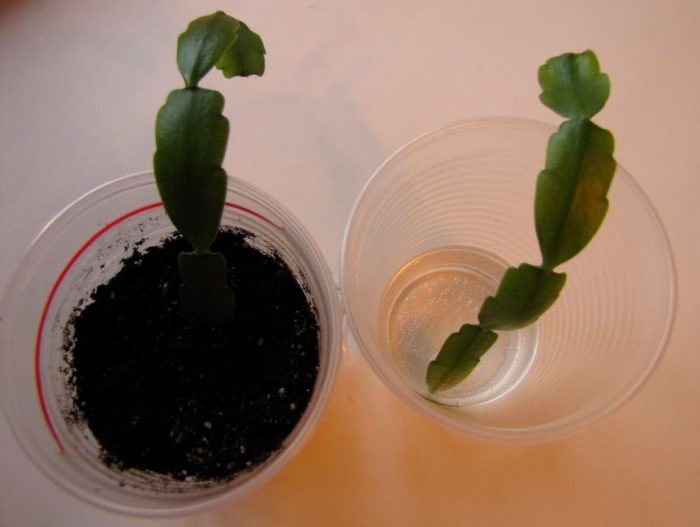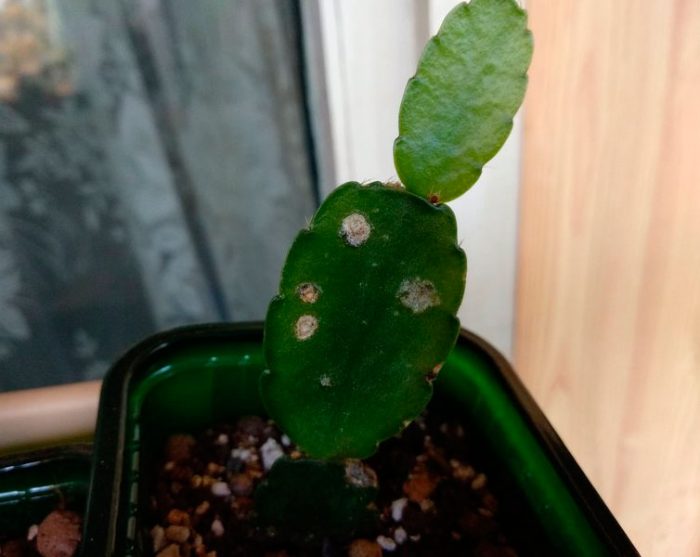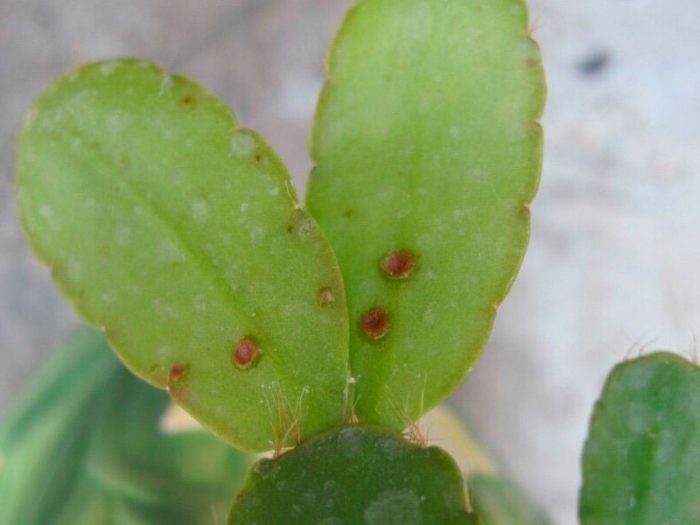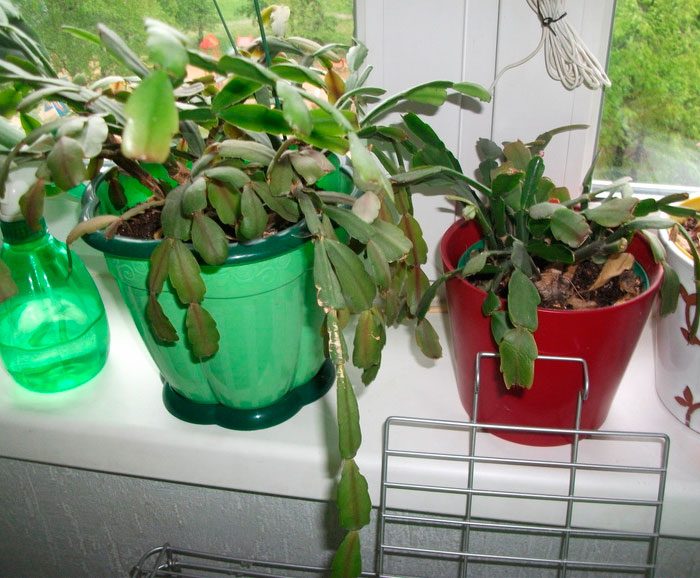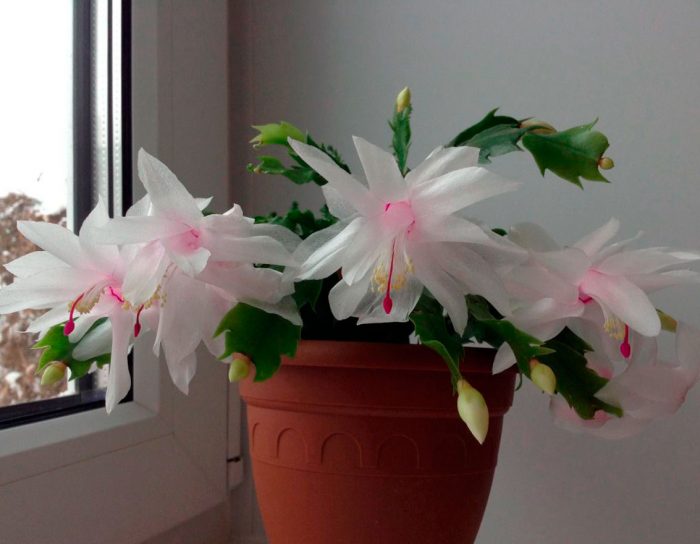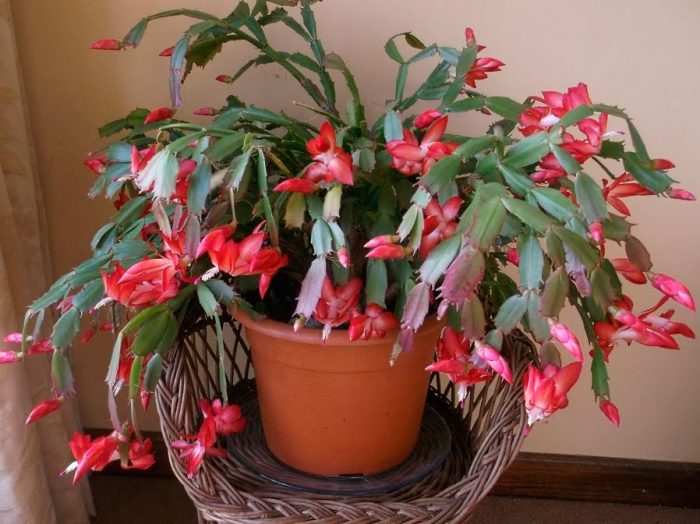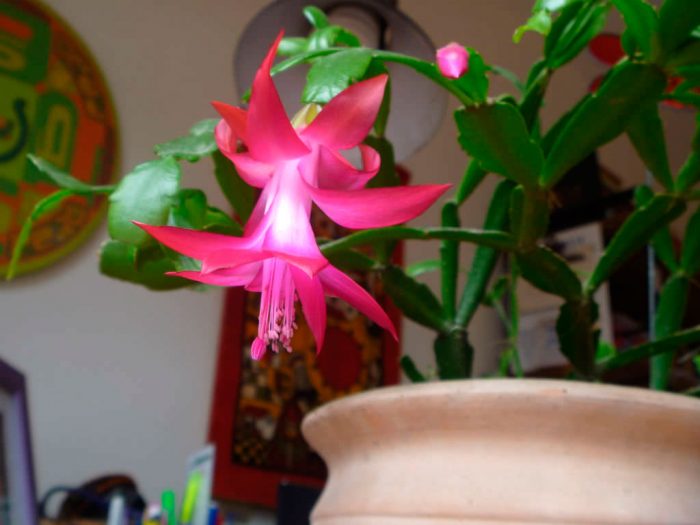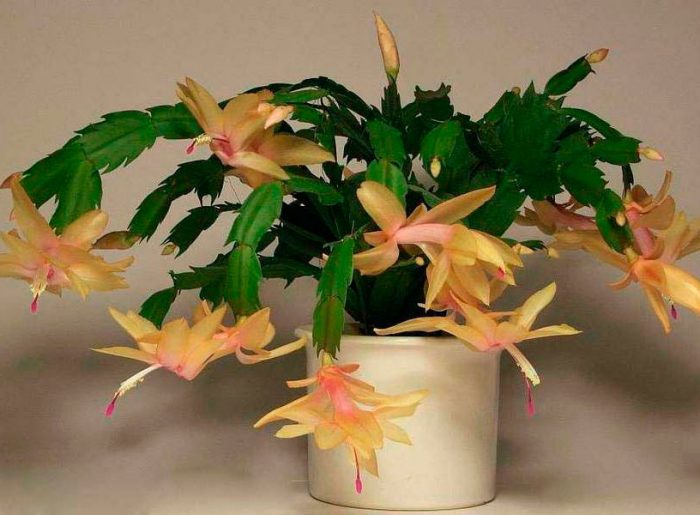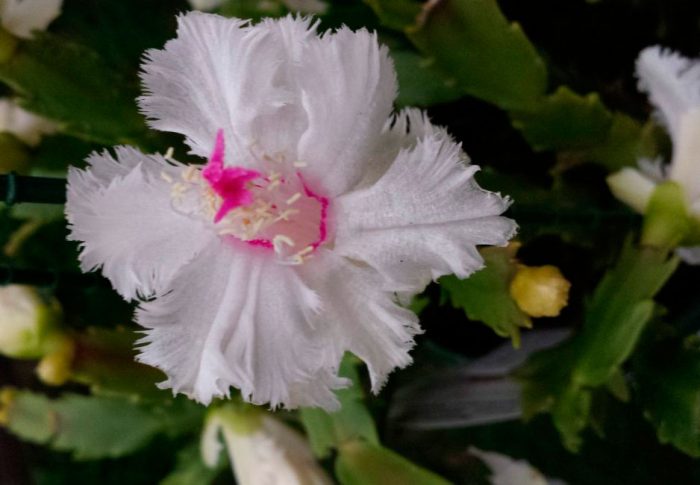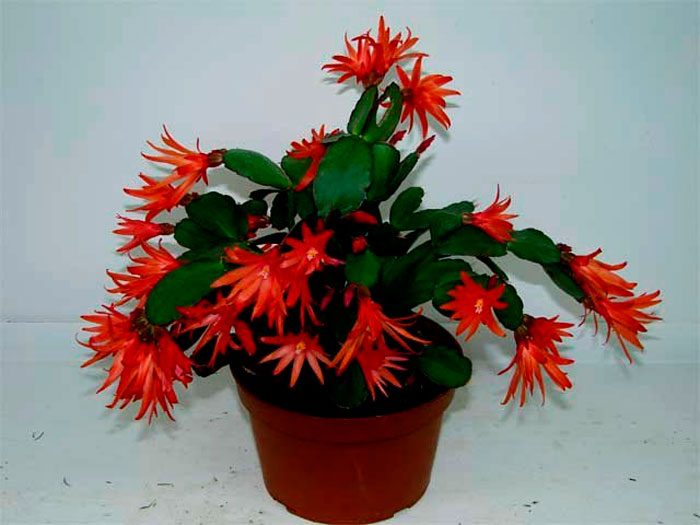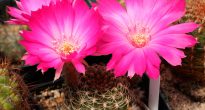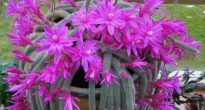In nature, there are cacti that are afraid of the sun, love water and have no thorns. Such a cactus is called Schlumbergera, or Decembrist, or Zygocactus. This plant is part of a genus of epiphytic South American cacti that grow on tree branches in tropical rainforests. Zygocactus blooms when a tropical summer is observed in its homeland, namely, in November or December, and flowering ends in the last days of January. The Decembrist was brought to the middle latitudes in 1816 by the collector Allan Cunningham.
Content
Brief description of cultivation
- Bloom... It is observed in winter, or rather, in December – January.
- Illumination... Slight shading or bright but diffused light. Windows of east or west orientation are perfect, but if the pot is on the south windowsill, then the flower will need shading at lunchtime.
- Temperature regime... Zygocactus is able to grow normally at temperatures between 18 and 40 degrees. But in summer, the flower grows and develops best at an air temperature of 18 to 22 degrees, and in winter - from 14 to 16 degrees.
- Watering... Moisten the potting soil moderately, after its surface dries to a depth of 10–30 mm.
- Air humidity... It should be elevated. To do this, in the summer, the bush must be moistened with a sprayer several times a week, in the winter months the number of sprays is reduced to 1-2 in 30 days.
- Fertilizer... The flower is fed once every half a month from March to September. To do this, use a mineral complex fertilizer for cacti.
- Dormant period... It is observed in October – November.
- Transfer... Young bushes are transplanted regularly once a year, adult plants are transplanted less often, or rather, once every 5 or 6 years.
- Pruning... To form the crown of the bush, unnecessary segments are carefully torn off by hand.
- Reproduction... By cuttings and grafting.
- Harmful insects... Spider mites, scale insects and mealybugs.
- Diseases... Phithium, late blight, fusarium, and also damage by bacteria of the Erwinia group.
Features of zygocactus
The Decembrist differs from many domestic flowers in that it blooms at a time when most of the plants have a dormant period. Such a plant has other features that a florist must know about:
- The flower is not recommended to grow on windowsills of western and southern orientation, as due to too much bright light, the final fragments of the stems may begin to die off at the bush.
- In summer, the plant needs a lot of fresh air. Therefore, at this time it is recommended to transfer it to a loggia, balcony or terrace, while for it you need to choose a place that is in shade.
- In summer, zygocactus responds very well to warm showers. If you do not have time for this, then at least systematically moisten the bush from a sprayer.
- If the Decembrist is provided with good care and suitable conditions for growth, then it will be able to grow normally and bloom regularly for 15–20 years.
- Schlumberger is one of those flowers that it is better not to disturb during bud formation. The flower pot should not be moved to another place or even turned, as this can provoke the dropping of the buds.
- If desired, zygocactus can be grown not only as an ordinary indoor flower, but also as an ampelous plant.
Caring for the Decembrist at home
Watering and humidity
The features of growing the Decembrist in room conditions are fundamentally different from those recommended for the cultivation of other cacti. Most of the rules of care are similar to those that apply to the cultivation of ordinary deciduous houseplants. For example, if you forget to moisten the substrate in a pot with a cactus in time, then nothing bad will happen because of this. But the zygocactus should be watered systematically, and use warm, well-settled water for this. It can also suffer from too dry air in the room, so it is recommended to systematically moisten the bush from a spray bottle. You can also increase the humidity of the air by placing a pot with a plant on a pallet, into which moistened pebbles are poured.
Illumination and temperature
Ordinary cacti tolerate the direct rays of the sun well, but the Schlumberger can be severely affected by them, so she requires mandatory shading. But it is not demanding on temperature, but it grows and develops best during the growing season in the cool (from 18 to 22 degrees).
Fertilizer
They begin to feed the flower in March, for this, with a frequency of 1 time per month, a complex mineral fertilizer for cacti is introduced into the soil mixture, while using a half dose of that recommended by the manufacturer on the package. In the summer, after the shoots begin to grow and develop intensively, the frequency of feeding is increased to two times every 30 days. With the onset of September, they stop fertilizing the substrate. Experienced growers recommend systematically treating the bush with a fungicide solution to protect it from fungal diseases.
Pruning
Formative flower pruning is carried out in June. For this, the excess part is not cut off, but carefully unscrewed by hand. As a rule, shoots that are too long are pruned, as well as those that grow incorrectly. In addition to the fact that after pruning the bush looks more impressive, this also has a positive effect on its flowering, which becomes more lush.
Decembrist transplant
The Decembrist is transplanted in the last days of February after it has finally faded. The transplant of young bushes is carried out once a year, and adult specimens - 1 time in 4 or 5 years. Since zygocactus has a superficial root system, a low but wide pot is used for planting it.At the bottom of the pot, a drainage layer is made, the thickness of which should be equal to 1/3 of the height of the container. For transplanting, use a ready-made commercial soil mixture for cacti. In order to prepare a soil mixture with your own hands, you need to combine leaf and sod soil, as well as sand (2: 1: 1). Then a little expanded clay or brick chips are added to the mixture for looseness, as well as quite a bit of coal powder for disinfection. The resulting substrate should be a slightly acidic reaction.


Watch this video on YouTube
Reproduction of the Decembrist
Most often, indoor zygocactus is propagated by cuttings. To begin with, two or three extreme "links" must be unscrewed from the stem, after which they are left in the fresh air for several days, where they should dry well. For rooting, the cuttings are planted in a moistened substrate, and on top they are covered with a cut plastic bottle or a transparent glass jar. Move the cuttings to a shaded area and provide them with systematic ventilation and coolness (15 to 20 degrees).
Most often, propagation by cuttings is carried out after the Schlumberger cuttings have been pruned, since after this procedure a large number of ready-made cuttings may remain.
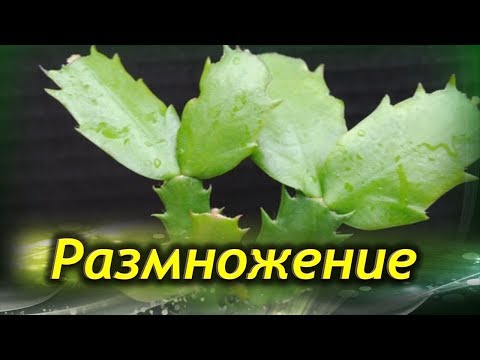

Watch this video on YouTube
Decembrist pests and diseases
Diseases
Zygocactus can suffer from fungal diseases, for example, from phytium, fusarium or phytophthora. The causative agents of these diseases can be in a poorly prepared substrate, from which they penetrate the flower, and the root collar of the plant is the first to be damaged. The affected bush becomes faded and has a grayish tint, and segments begin to die off. As a result, the flower begins to fade even with systematic watering. In order to get rid of fusarium, the Decembrist is treated with a solution of a special fungicidal agent, and if it is affected by phytophthora and phytium, the bush is sprayed with Topaz, Maxim or Vitaros.
Harmful insects
The appearance of a rusty coating on the surface of the bush may indicate that a spider mite has settled on it. It is a very small insect with a yellow, brown or pale red color that is almost impossible to see with the naked eye. A tick appears where very low air humidity is observed for a long time. To destroy such a pest, the bush is sprayed with Fitoverm, Aktellik or Neoron.
If you see white lumps between the stems that look like cotton wool, then this is a sure sign that mealybugs have settled on the flower. In order to get rid of them, treat the bush with Aktara's solution.
Possible problems
With improper care with zygocactus, problems may arise, for example:
- Withering bush... The wilting of a plant may be due to the fact that it is affected by phytium or late blight. Also, shoots can become lethargic due to root system disease. If the trunk of the bush is swinging and has become unstable, then this may be due to the fact that the roots of the flower have already died out as a result of hypothermia (the room is too cold or the bush was watered with very cold water). Also, the roots could die due to the fact that the pot overheated in the sun. A very high concentration fertilizer solution can also severely damage the root system. In this case, the Decembrist is immediately transplanted into a fresh soil mixture, otherwise the concentrated solution can completely burn the roots.
- Lack of flowering... The zygocactus will not bloom until it senses that it is time to bloom. For this to happen, the flower needs to be provided with a full dormant period. To do this, from the last days of September to the end of November, the plant is transferred to a cold room, at this time it is not fed and watered very rarely and with a small amount of water (make sure that the lump of earth in the pot does not dry out).In the last days of November, move the Decembrist to a warm and well-lit place, and start watering it systematically. Rotate the bush regularly around its axis, so that all sides of it will be evenly lit. After the buds appear, do not allow the clod of earth in the pot to dry out, and do not turn or transfer the bush to another place, otherwise all the buds may fly around it. If everything is done correctly, then the zygocactus will undoubtedly delight you with lush flowering.
- Dying off and flying around segments... In some cases, the leaves of a seemingly perfect healthy bush may begin to die off and fall off. Most often, the segments die off due to the fact that a spider mite has settled on the bush. In the event that the pest was not found, then the "leaf fall" may be associated with a lack of nutrients (too poor substrate or very rare feeding). In this case, the bush needs to be fed 1-2 times on the leaf with a solution of fertilizers for epiphytic cacti, then it is added to the substrate. If even after such feeding, the segments continue to fall, then the plant will have to be transplanted into a fresh soil mixture. If the end segments fly around, then the reason for this may be excessively low air humidity or stress (a change in the environment, a sharp fluctuation in daily temperatures, an untimely transplant or a draft).
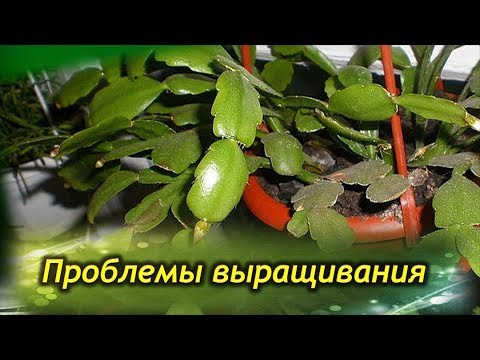

Watch this video on YouTube
Post-flowering care
After the flowering of Schlumberger is over, it should be rearranged to a cooler place and watering should be gradually reduced. The growing season for the flower begins in the last days of March, so at this time it must be rearranged to its usual place in the warmth. Gradually increase watering and provide the plant with timely feeding.
Types of the Decembrist with photos and names
Buckley
The Decembrist of the Buckley variety is considered the most persistent. It withstands change of scenery and some shortcomings in grooming well. "Buckley" grows 40-50 centimeters, it turns out to be a large and lush bush. The Decembrist variety has large buds. They can be up to eight centimeters long.
The Decembrist flower of the Buckley variety is distinguished by a variety of flowers. They can be of various colors. But the leaves are always dark green.
This zygocactus blooms from November to March. Such a long period of bud formation cannot but please.
White
Decembrist variety "White" looks very gentle and elegant at the same time. Usually, such a plant blooms profusely. Sometimes the stems and leaves are not visible under the buds. Flowers at "White" are large.
Truncated
This type of zygocactus is characterized by light green pointed leaves and a variety of flowers. The stems of the plant reach six centimeters and have teeth at the edge.
Flowers of the Decembrist "Truncated" two-tiered. They have petals bent back. The colors of such a zygocactus are very diverse. The buds can be purple, white, pink, orange and combination colors. That is why this variety is especially popular.
Russeliana
This Decembrist grows no higher than thirty centimeters. Its leaves are flat and glossy. It is worth noting that this variety of zygocactus has no needles, which makes it very cute. The peduncle tube of this plant variety is green. The buds themselves can be red, pink, purple. The short stature and abundance of colors make the Russeliana variety very attractive. He can decorate any room.
It should be noted that Russeliana is also resistant to negative environmental factors. This makes it popular among the population, because it is easier to care for an unpretentious plant.
Golden Cream
This Decembrist variety is very interesting. The fact is that it has yellow inflorescences. Moreover, their shade is gentle and pleasant, downright sunny. It should be noted that in nature, Decembrists do not bloom yellow. But the breeders tried and bred this species. They had to work for a long time, the task before them was not an easy one.Yet they managed to create a warm sunny Decembrist.
Aspen
This zagocactus is terry. It blooms white and pale pink. The plant's stamens are yellow. The Decembrist of this variety is a bit like a carnation during flowering. It looks very solemn. It is good to place such a plant in a hall, where there is a lot of space and the flower can appear in all its glory.
Gertner
The Decembrist of "Gertner" is very bright and beautiful. Its flowers resemble bells with pointed petals. The buds are bright red-orange in color. The leaves are dark green. This color contrasts sharply, which makes "Gertner" very noticeable and expressive.
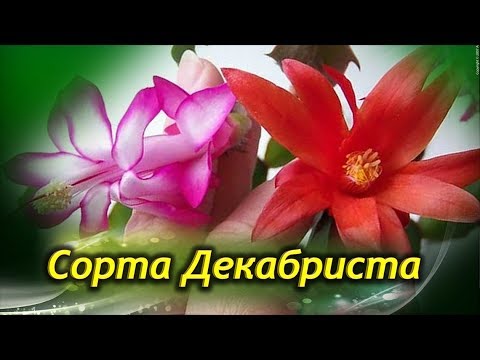

Watch this video on YouTube

